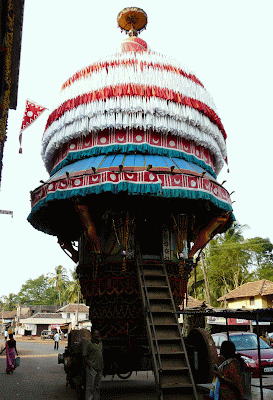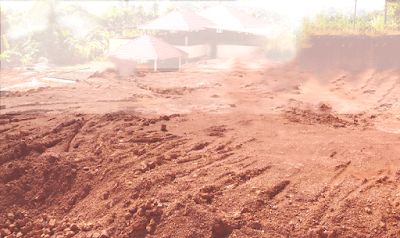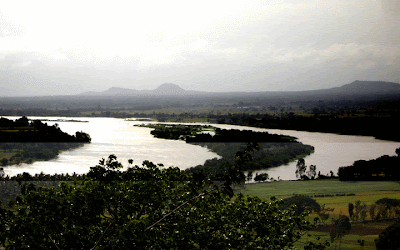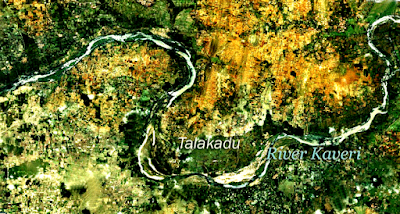In view of the revival of interest in Tulu people relating to their history and heritage as evident from the several recent comments that have been posted to this blog and from the several publications that have come out, a summary conspectus on the evolution of the Bunts and the Nadavas appears apt. A few of the recent comments posted on the topic of ‘Bunts & Nairs’ run like this:
1. “I am a bunt originally from udupi and the paddanas I have heard mention us the bunts as nagavansham kshatriya the original nagaradhakas (serpent worshippers) who came from the serpent kingdom of akshikshetra in the north (Badakaye in tulu). Akshikshetra is somewhere in Uttarakhand near Nepal-Tibet border. There Newars or Newari people are known to be serpent worshippers. Do we have a connection to them? Also many of us bunts at least I have slight mongoloid features not very prevalent, but you can observe many of us bunts not all have slightly smaller eyes like B.R.Shetty or Ajit Shetty of Jannsen Pharmaceuticals or even Aishwarya Rai who eyes are slightly smaller and curved .This again points to Scythian Naga origins what say? Bunts are also the comeliest people in south India. Some of us bunts are tanned but never dark.”
2).”The Nadavaru of Ankola, Kumta are not related to the Bunts. They do not practice matrilineality and serpent worship which is integral to bunts, nairs culture. I have seen these nadavaru trying to show relation to us bunts but they are not related expect that Naadava and nadavaru sound similar. But Bunt Nadava and Nadavaru are completely different”
3). “The Bunts and Nairs definitely do not have north Indian connection , the reason being in north India Hinduism was very strong , the nairs and bunts embraced Hinduism very late basically after the brahmins came down to south. This is the reason why inspite the bunts and nairs being warriors by profession were never considered as Kshatriyas by the brahmins but shudras.”

Related genetically
Tulu pāDdana songs, especially, Koraga ‘Urals’ known to pronounce philosophically that the Nadava, Billava and Mogaveera people are the children of the sisters. Since the pāDdanas are composed by some of the aboriginal tribes of the land who have hereditarily witnessed a large span of the bygone history, there may be certain elements of truth in the said dictum. At the same time, as a consequence of periodical immigrations various assimilations have possibly been introduced in most of these communities during the complex course of evolution. Essentially, time and space, with attendant natural factors, have introduced numerous variations, apart from several lines of synthesis, among the various Tulu communities.
Nadava, Bunt and Nair
The tripartite caption basically suggests that it is a composition of at least three groups naturally during the course of historical progression. However, in reality, there could be more than these three individual community units that assimilated or merged with these in the historical past. While this is appears rather explicit in the case of Nadava-Bunts-Nairs, this could be the case with every other Tulu community or even every other group in the world.
Many apparent and obvious facts have been camouflaged during the progressive course of evolution of various communities. The sequential order of Nadava- Bunt- Nair appears to be the actual chronological order of formation of the community, which is one of the major Tulu Diaspora.
NāDava: Origin & antiquity
Nadava, as the word analysis explains, basically represents the cultivator or the farmer. The word ‘naDu’ is to plant seedlings. And the word ‘nāDu’ derived from the root ‘naDu’ originally meant cultivated area. In the course of time, the scope of the meaning of the word ‘nāDu’ was expanded to signify country, a cultivated and evolved area as compared to kāDu the forest. This meaning is obvious when we compare the word ‘nāDu‘(na+aDu) with ‘kāDu’ (ka+aDu). In these words the suffix ‘aDu’ represents area with trees or plants. Compare ‘aDu’ with plain ‘Da’. The latter suffix means area or locality in Munda languages. It is well known that the ‘kāDu’(=forest) areas were converted to ‘nāDu’( cultivated area) with introduction of systematic agriculture during the course of evolution.
Many of the Tulu researchers are searching for Nadava-Bunt roots in various royal families like Shatavahana, Rastrakuta, Chalukya, Jat etc, who lived and reigned during the period 2nd Century CE to10th Century CE or so. The origin of Nadava clan is much more older dating back to not less than ca. 3000 BC in the peninsular India.
It has been deciphered that the agriculture was introduced in the Nile River Valley during 6000 BC. Similar archeo-botanical AMS carbon datings on fossil seed grains recovered from the ash-mounds of Ballary region,Karnataka reveal that during the period 2500-1800 BC pulses like horse-gram(‘kudu’), black-gram('urdu’) and red-gram(‘togori’) were grown in the peninsula(Fuller & Harvey,2006). Note that ‘kuDu’ (=ku+Du =’good crop’; horse gram) was one of the earliest and widely grown pulse in southern India.
One of the interesting facts revealed by archeo-botanical research in southern India is that rice was unknown or not grown in the peninsula up to ca 800-600 BC! It has been suggested that Dravidian immigrant tribes brought the rice cultivation to southern India. Linguists are confused regarding the identity of the agricultural tribes that lived in the peninsula during the period 3000-1000 BC. Fuller & Harvey (2006) and Southworth, for example, have based their analysis and inferences considering that the tribes liveearly natives as Dravidians. However, extensive place names in Tulunadu (and also Karnataka) suggest that widespread clans of Munda tribes were living in these regions in the past.
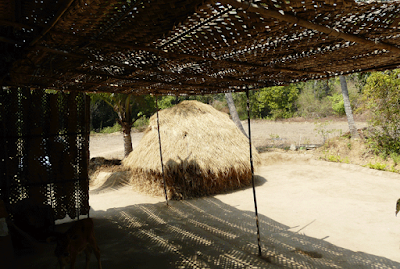
It has been deduced (especially, in this blog, based on place name analysis) that Munda –Gond Group of tribes lived in different parts of the peninsula, till the immigration of Dravidian tribes. The Dravidian tribes invading from the north introduced the rice cultivation here. Thus ancient the words Da, aDu, kāDu, nāDu, kudu etc must have been originally from the language of early Munda tribes.
Therefore, the earliest NāDava farmers in this terrain were from the Munda, Gond and other ancient tribes. Numerous village names bearing signature of ancient tribes of Aria, Bage, Banna, Bella (Vellar>Ballal), Baira, Bhil, Bonda, Gadaba, Gonda, Idiya, Irava, Kalavar, Kakke, Kannar, Kol, Kosa, Koti, Koya, Kotru, Kukke, Marava, Mande, Munda, Moolya, Pani, Panaba, Yedava and other tribes suggest that these lived once upon a time in the region now known as Tulunadu.
With immigration of Dravidians into the peninsula, and with passage of time, there has been cultural, lingual and genetic assimilation of preexisting and immigrant tribes. Original Munda words, customs and culture have been assimilated into Dravidian languages. In other words Dravidian languages including Tulu grew and evolved on a platform of Munda words and language. Words cited earlier like aDu, Da, kaDu, naDu, kudu, paDi, paDa, vaDa, VaDi, baDa baDi etc were originally from Munda Gond languages but absorbed seamlessly later into the Dravidian.
The surnames and lineage names of Nadavas suggest selective assimilation of several ancient tribes into their folds. Some of the ancient customs prevalent among Nadavas, based on ancient Munda-Gond traditional practices and beliefs also suggest the theme of socio-cultural assimilation during the prolonged course of evolution.
Keshav Shetty Adur (2007) for example cites the custom of ‘moori deepini’ as suggestive of moolya derivation of some nadava clans. The ’moori’ is a small earthen pot.It is being worshipped in some Ballal families as a form of divinity. It is possible that the ‘moori’ (=earthen pot) represents the original and primitive form of ‘kalasha’ pooja, which evolved subsequently to replace the ancient earthen vessel with a metal (usually copper or brass) pitcher.
And other streams of Nādava farmers were spread all over the peninsula. Kaviraja Marga describes Nādava from Kannada region. With time the word ‘nāDu’ (cultivated land) attained meaning of country or state and the word ‘nāDava’ (farmer) acquired the additional meaning of a citizen.
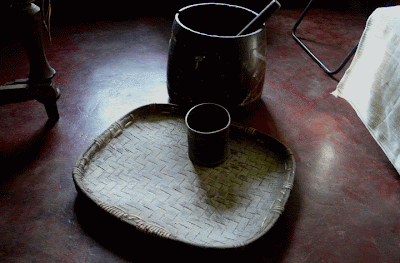 Okkelme
Okkelme
An alternate term for the Tulu Nadava is ‘Okkelme’. Rural folks still use the word to denote Nādava farmers. The word ‘Okkel’ originally meant a farm house, since ‘okku’ =to dig the earth. And the ‘Okkelme’ was the farmer who resided in the farm house near his agricultural fields. With passage of time the word ‘okkel’ has evolved to mean occupied residence or occupant of a house.
In Siri paDdana, Birmu Malava expains that he belongs to Ariya-bannar lineage and Okketti caste. The form Okketti may the older version of the usage Okkelme.
Farmer-soldier-merchant
Nadava youth were also drawn as soldiers during wars. Some of the soldiers from Karavali were taken to northern Karnataka and Andhra for combating with enemies. And similarly there have been periodic influx of soldiers from the Malnad and upland areas during events of major wars in the Karavali. The soldiers settled in the Karavali and mostly mixed with the local population.
With the background of farmer-soldier profession Nadavas became close to rulers of the land and slowly evolved to become landlords, the owners of Guthu, Barike and Boodu. With time they also became merchants as evident from the widespread surname ‘Shetty’ (derived from the word ‘Sheshti’, the merchant). Assimilation of affluent Jain merchants immigrants from upghat regions into Nadava communities possibly introduced surnames like Shetty and Shresti.
Nadava communities like others have undergone a sequence of theological modifications that have affected the land. To begin with, Nadavas from Munda communities were Spirit and Naga worshippers. Subsequently, they were swayed by the tenets of Buddhism, Jainism and Hinduism. Thus they have inherited essence and footprints of several religions in the land. And the interplay of religions possibly kept them outside the shackles of chaturvarna, sensu stricto. Since they were farmers, landlords, warriors and merchants, at different levels in time and space there is no justification in pondering if they were exclusively of ‘kshatriya’ (warrior class) anytime.
Bunts
The Kings and overlords of Tulunadu employed martially trained, well built young men as trusted personal assistants who acted as professional body guards and warriors, apart from carrying out miscellaneous jobs entrusted to them.
"Bunt" or ‘banta’, (pronounced ‘banT’ or ‘banTa’) as the word explains, stands for a trusted assistant. Apparently bunt was a occupational term in the past rather than a caste indicator. Koti – Chennayya, the twin Tulu heroes, hailing from the Baidya -Billava community, were described as ‘bantas’ in the folklore. They served Tulu Chieftains as personal assistants or henchmen. Many of the native gymnasia (known as ‘Garodi’s) that trained soldiers were run by Billava people.
The word Bantu apparently is derived originally from African sources. The word ‘Bantu’ in African languages means people. African Bantus migrated to different areas from homeland in tune with periods of adversity. It appears that the word ‘bunt’ or ‘buntu’ could have travelled to the Indian peninsula along with Dravidian migrants from the African continent in the past. Analogy of the meanings the original African word ‘bantu’ (=people, persons) and the Tulu word ‘bant’ (=aide, assistant) may be noted.
Genetic studies have confirmed that early man originated in African continent and migrated to various parts of the world. There have been several cycles of emigration of people from African continent. Of these the migration of Dravidians fro Mediterranean region to NW Indian (ca 2000-1700 BC) and further to southern India (ca 800-400 BC) appears to be prominent markers that have left several significant socio-cultural imprints.
Immigration of people from Africa and Mediterranean region possibly took place in several stages, with each stage having several intermediate halts on the way. The well built Scythian and Mediterranean physical features attributed to Bunts and other Tulu people were possibly derived from the immigrants.
That the word ‘bunt’ was a occupational term is also evident by the fact that soldiers brought from upland peninsular areas after 16th century CE ( for fighting war with local chieftains) were called ‘Parivar Bunts’. They have also settled in Tulunadu as ‘Parivar Bunts’ but have not assimilated with native Bunts. The ‘Parivar’ tag is a modification of the original word ‘paravar’ which represents marine fisher-folks.
The word ‘bunt’ as a community indicator is more prevalent in southern part of Tulunadu. The professional ‘bunts’ in the past could have adapted to agriculture and farming in the war- free peace periods, leading to matrimonial alliance with Nadava families.
Bant
villages in India
There are three official Bant villages in
Tulunadu: Bantawal, Bantra (Puttur Taluk) and Bantakal (Udupi Taluk). There are also a number of hamlets in the
coastal districts having the name of Bant, of which the statistics is not
readily available.
But if you think “Bant” villages bearing the
name of “Bant” or “Banta” are exclusive to Tulunadu, you are wrong.
In fact, there are some 155+ Bant villages in different parts of India
(The number excludes the names of hamlets and settlements beginning with prefix
of Bant. ) as per Census data for 2011.
The list includes village names such as Bant, Banta, Bantara, Bantera, Bantoli,
Bantpura, Bantikhera, Bantari, Bantor,
Bantwa, Bantwara, Bantwada, Bantwadi, Bantavaram, Banthu, Banthla, bantupalle,
Bantkhani, Bantikula, Bantow, Bantail, bantahalli, Bantarahalli, Bantenahalli,
Bantiganahalli, Bantihal, Bantugram, Bantugaon, Bantakunta, eetc. These
villages are distributed in Orissa (34), Uttar Pradesh (34), Assam (14),
Rajsthan (13), Andhra Pradesh (11), Gujarat (10), Karnataka (10) Jharkhand(7),
Uttarakhand (7), West Bengal (6), Bihar(5), Himachal Pradesh (3), Madhya Pradesh
(2) and Maharashtra (1).
One aspect that we can understand from the
distribution of ancient Bant village names is that Bant(u) was an ancient
tribe that was fairly well distributed
in various parts of India. Another inference is that some of the original
ancient Bantu tribes might have immigrated to India from their African
homelands in the remote antiquity in search of better pastures.
the names of hamlets and settlements beginning
with prefix of Bant. ) as per Census
data for 2011. The list includes village names such as Bant, Banta, Bantara,
Bantera, Bantoli, Bantpura, Bantikhera, Bantari, Bantor, Bantwa, Bantwara, Bantwada, Bantwadi,
Bantavaram, Banthu, Banthla, bantupalle, Bantkhani, Bantikula, Bantow, Bantail,
bantahalli, Bantarahalli, Bantenahalli, Bantiganahalli, Bantihal, Bantugram,
Bantugaon, Bantakunta, eetc. These villages are distributed in Orissa (34),
Uttar Pradesh (34), Assam (14), Rajsthan (13), Andhra Pradesh (11), Gujarat
(10), Karnataka (10) Jharkhand(7), Uttarakhand (7), West Bengal (6), Bihar(5),
Himachal Pradesh (3), Madhya Pradesh (2) and Maharashtra (1).
One aspect that we can understand from the
distribution of ancient Bant village names is that Bant(u) was an ancient
tribe that was fairly well distributed
in various parts of India. Another inference is that some of the original
ancient Bantu tribes might have immigrated to India from their African
homelands in the remote antiquity in search of better pastures.
Several researchers have proposed that the Neyer community from sub-Himalayan or Tibetan region migrated to southern India and settled in Kerala as Nairs. Apart from analogy of the words ‘Neyer’ and ‘Nair’, the Nairs probably brought with them art (dance-drama forms of Yakshagana, Kathakali and Bayalata) and architecture (pyramidal roof structure) from north to south. The costumes of Yakshagana and Kathakali have retained northern dress code elements in spite of being popular in the south. Similarly the pyramidal house roof designs of the Karavali and Kerala reflect and mimic the Nepali or Tibetan pyramidal temple roof designs. Some of these cultural and archetectural features could have been brought to by Buddhists also.It is said Nairs migrated to south along with Brahmins, probably during the reign of Kadamba King Mayura Varma. The assimilation of Nairs with Tulu Nadava-Bunt community in Karavali in the past has been dealt in the earlier post by Kawdoor Narayana Shetty.
It is speculated that the matrilarcheal system and the ‘aliya-kattu’ (property inheritance to sister’s son or nephew inheritence) came into practice after the advent of Nairs into Karavali and Kerala. Specific polyandrous and joint family conditions as prevalent with Nambudaries, wherein identification of children was dubious, might have paved way for introduction of the Nephew inheritance or aliya-kattu system among Malayalis which was later adopted by the adjacent Tulu communities as a consequence of propagation of the legend of mythical Bhootala Pandya.
Thus the mongoloid facial features, referred in the comment, were possibly genetically derived from northern Neyer or Buddhist sources. Even the Natha Jogis (of Kadri and other areas) had cultural connections with Nepal since ca. 8th Century CE.The Brahmins and Nairs possibly came together from the North during Kadamba period. Their arrival into Tulunadu and Kerala gave special impetus to the growth of Hinduism in these areas which gradually replaced the foundations of Buddhism in the region.
Uttara Kannada Nadavas
Five Nadava families from Kundapur area migrated to Kumta -Ankola region some 500 years ago according to the legends prevalent among Nadava families of Uttara Kannada. Apart from the ancestral memories of the people emigrated, similarities in language and customs of the two regions support this legend. Nadava Nayaks probably emigrated from upghat areas along with royal armies.
Apparent absence of matrilineality or deeper Naga worship among them may not be enough factors to separate Uttara Kannada Nadavas from the Dakshina Kannada Nadavas. The migrated Nadavas naturally have adjusted to the Vedic customs of the region where they settled. They worship Tirupati Venkataramana as family God like most people of Uttara Kannada, while southerners predominantly worship variants of Goddess Durga or God Shiva.
The Kannada Nadavas have lineage (balli) names generally distinct and different from Tulu Nadavas.
There are several relic features that imply the interplay of the rudiments of matrilineal system among the Uttara Kannada Nadavas also in their cultural backdrop, such as:
1. Nadavas of Kundapaur and Ankola region, apart from the language, share certain similar matrilineal septa (‘balli’) systems (like Ajji bali, Kujji bali, Chandi bali, Dāri bali, Dāni bali, Kyandagi bali, Rāni bali, Hole bali, Ane bali, Segi bali, Settibali,Tolera bali and Siri bali etc) to prove their common origin.
2. Bride is brought to the marriage hall by her maternal uncle.
3. Traditionally, the dowry (‘tira’) is paid to the bride. The custom of offering ‘tara ’(=bride price) also existed formerly among most of the Tulu communities. The custom was inherited from the ancient ancestors of Munda -Gond tribes.
4. The Nadava parents give a share of their property to their daughters also.
The family bonds and social interactions among the migrated Nadavas are rather well knit and intimate. This could be because they were a small group to begin with. Further, since the Nadava parents lived together probably there was no necessity of perpetuating the matrilineal or aliya-kattu customs.
Absence of Chaturvarna
The absence of well defined Chaturvarna among Tulu tribes has been a matter of debate. The early spread of Buddhism in the region (ca.300 BC to 700 CE) super-imposed on a older Spirit-Naga worshipping tribal environment encouraged perpetuation of a classless society in Tulunadu and Kerala. Even with the advent of Brahmins and Nairs into the Tulunadu it was not possible to enforce a society divided into Chaturvarna as in the North because the local population was not willing to accept it.
People switched over to the tenets of Hinduism but the native Alupa rulers did not believe in the efficiency of four layered caste system. Besides, neither the Alupa rulers nor the Nadava-Bunt alliance were full time warriors. Nadavas were farmers or landlords during the peace times. During war time they recruited ‘bunts’ trained in native martial arts and the wars were fought with the help of warrior ‘bants’ who also hailed from diverse communities. For example, in the ancient Tulu society, Billava youths (Bhil tribes, traditional archers; bhil=bow) were strong in the field of war-craft. Most of the ‘Garodi’ institutions (native gymnasia of Tulunadu) were run and maintained by Billavas. Some of the Billava were the ‘baidya’s who practised indigenous system of medicine that evolved into Ayurveda subsequently. Another section of Billava used to resort to the occupation of toddy tapping. Thus Tulu communities followed diverse trades that eluded them the exclusive classification of Chaturvarna.
The Alupa power and wealth was based on sea-faring merchant boats (called ‘Pandi’-s) and prided themselves as ‘Pandya’ Kings, the term ‘Pandya’ or ‘Pandia’ being a Pandi owner. The Alupa (‘Aluper’ in Tulu, originally hailed from ‘Alupe’ village near Mangalore) were essentially rich merchants. Thus the Alupa were probably from the sea-faring fisher-folks and not typical war loving ‘kshatriya’s as defined by the Chaturvarna system adopted and followed by north Indian Kings.
Bunt-Jain conversions
Conversions from Bunts to Jains and vice versa in the Karavali during the mideval period has been noted by several researchers.Basically the presence of some of the common surnames shared among Jains and Bunts, serve evidence for the conversions that occurred in the past.It seems that in general the subjects opted to convert into the religion/community of the ruler to appease him. Or the rulers preferred that his subjects should adopt to the religion of the ruler. Monks and religious leaders powerful during the regal period also played amajor role in converting the kings as well as his subjects.
Evidence from lineages
Modern genome studies provide scientific evidences to decipher aspects of evolution, migration and dispersal of communities. Detailed genetic studies on various Tulu and Karavali communities have not been attempted so far. However, in the absence of detailed genome studies, the available information from the lineages (known as bari [Tulu] , bali [Kundapura] or baLLi [Ankola]) provide us preliminary evidences on the genetic evolution of Tulu communities such as Nadavas.
Nadava 104 surnames
According to Sacchidananda Hegde (2009) there are 32 Bari and 104 surnames among Tulu Nadavas. It is possible that many septa/lineage names and surnames among Tulu Nadavas have been lost during the course of evolution or have not been accounted so far.
Adyanthaya,Adapa,Alva,Ajila,,Ajiri,Attar,Arasa,Athikari,Adasu,Ariga,Athri,Banga,Banta,Ballala,Baari,Binnaje,Baaga,Bhandari,Bunnala,Budale,Branna,Baitani,Bhoja,Binnani,Chavuta,Dore,Gaambir,Gavuda,Hegde,Horuva,Kadaba,Kambli,Kakva,Kayya,Kaariyala,Kaava,KundahegdeKaajava,Kantiva,Kille,Kella,Kalle,,Kotari(Kotriyal),Konde,KurlaHegde,Kudre,KundaaDe,Maddala,Marte,Mallala,MaaNa,MāNayi,Malli,Malyal,Mārla,MāDa,MārDi,Moola,Marala,Munda,Munder,Mudva,Muraayya,Mukkala,MeNava,MelanTa,MenDa,Nādava,NayiriHegde,Nanaya,Naik,NoanDa,Pakkala,PaDyar,PaTla(shetty),PayyaDe,Palayi,Pāla(PaDyala),PānDi,Pegde,PergaDe,Poonja,PoovaNi,Raja,Rai,Shetty(Shettyal),Shettavala,Sheba,Sheka,Shenava,Sanakaya,Shresta, Santha,Samani, Samantha, Sorafa, Sulaya, SooDa, Servegara, Semitha, Tunga, Tolar, Vāla and Varma.
Banta/ Nadava baris'
Sacchidananda Hegde (2009) reports 32 bari /lineages among Tulu Nadavas and 14 balli/lineages among Kannada Nadavas. According to him the prevalent Tulu Nadava (Bant) bari lineages are:
1.Ammannya,
2.Aryabannaya,
3.Anchannaya,
4.Bangarannaya,
5.Bannannaya,
6.Bermetibannaya,
7.Bhagyatannaya,
8.Chavadithannaya,
9.Gondarannya,
10.Gujjarannaya,
11.Gurjilbannaya,
12.Hiribannaya,
13.Kallarannaya,
14.Karmarannaya,
15.Kochatbannaya,
16.Kongannaya,
17.Kotirannaya,
18.Kunderannya,
19.Nandarannaya,
20.Nelabannaya,
21.Pangalannaya,
22.Pulyottannaya,
23.Pergadebannaya,
24.Putrannaya,
25.Salyannaya,
26.Siribannaya,
27.Tingalannaya,
28.Uddarannaya,
29.Ujetbannaya,
30.Ulibannaya,
31.Upparannaya.
The list above may not be comprehensive. Keshava Shetty Adur (2007) for example, cites additional lineages like Koyarannaya, Odarannaya etc. Shekar (2009) has documented Aysaranna, Bavunt, Binnara, Dangalanna, Gundlanna, Gulavelananna, Kabaranna, Kādanna, Kamberanna, Kelakachadara, Kodanaganna, Koraganna, Narayanna, Puttabari, Shettar, Taranna, Taralanna, Tolar, etc., lineages. (The interchangeable suffix –anna (=brother) or –annaya have been traditionally added to the lineage names for showing respect.)
Banta baris /Nadava Balis
(compiled after Dr. Indira Hegde, 2004):
1. Abbe/Apya
2
Ammannya/Ammanna
3. Ariya/Ariya bannaya [ : > Ariga? ]*
4. Ajiranna/Ajirannaya >
Ajiri
5. Uppinakule/Uppannaya [> Uttar bali> Huttinabali ?]
6. Ullittaya
7. Airanna/Airannaya
8. Odeyar/Odarannaya/Oddannaya
9. Kadira/Kadirabannaya
10. Kadamba> Gadaba/Kadaba
11. Kabara/Kabarabannaya [> Salanna bali ]
12. Karmaram,/Karmara bannaya
13. Kayya/Kayara/kayyarannaya [ < Koira?]
14. Karmaram/Karmarannaya
15. Kavudichi
16. Kadyannaya/Kadarannaya
17. Kinjhanna
18. Kundar/Kundarannaya
19. Kumarannaya/kumaran/ Kochati
bali
20. Kella/Kellarannaya
21. Kodange/Kodangannaya
22. Kommi/Komati/Kombisetti > [< Kom ? ]
23. Kongaru/Kongarannaya
24. Koriannaya
25. Kochusetti/ Kochati bannaya
26. Gujar/Gorjara/Gujarannaya/ < Gurjar
27. Guvellannaya/ Kovela blai [>
Coelho ? ]
28. Gundar/Gundarannaya
29. Chanda/Chandra/Chandra bannaya
30. Charpadi/Charpadi bannaya
31. Chittan
33. Jaji bali/ Chojarannaya
34. Talaranna/Talrannaya
35. Tolar/Tolaha
36. Nandar/Nandarannaya
37. Nattanna/Nattannaya
38. Narayana bali
39. Nayanar
40. Nallim bali/Nalannaya
41. Naga bali/Tolar bali
42. Nadavar
bali/Nadrannaya/Nadarnnaya
43. Navaram bali
44. Navatam/ Mantu bali
45. Nelapadi bali/Nelapadi
bannaya
46. Pangola/Pangolabannaya [<
Pangala?]
47. Putra/Putra bannaya
48. Pular/Pulisetti/Pulatabamnnaya/Pullyottu
49. Pergade
50. Peyr
51. Bangara/angarabannaya
52. Bandaranna
53. Bagi setti Bagattanaya
54. Baale
55. Bunnala /Binnani
/Bunnarannaya
56. Bermar./ Bermarannaya/Bermati
bannaya
57. Belana
58. Mayila/Mayiala bannaya
59. Raanoji
60. Salava/Salannaya/Talyannaya
61. Siri bali/Siriya bannaya
62. Setti bali/
63. Pongarannaya/Pongara/Hangaru bali
64. Haavina bali
65. Hasina bali
* [Notes within the brackets above are the possible derivations suggested by the blogger]
Nadavas of Uttara Kannada have the concept of ancestral house known as "mane" similar to "taravad" or "bari" or "bali" . One of the "
mane" (=house) is "
Hanumana mane".
It is evident from the available data that Nadava community has undergone complex evolutionary history. A simple single source model of genetic derivation cannot logically answer the complex evolution the community has undergone during the last 5000 years.
The available lineage and surname data can be tentatively classified into possible composite derivations from (1) Ancient tribes (2) Immigrant Tulu and other tribes (3) Religious associations and (4) Designations and Occupations.
1. Lineages suggestive of derivation from ancient tribes:
Bhagyatannaya, Gondarannya, Kādanna, Kallarannaya, Karmarannaya, Kochatbannaya, Kongannaya, Koraganna, Kotirannaya, Koyarannaya, Nandarannaya, Saliyannaya .
1a. Surnames suggestive of derivation from ancient tribes: Ajila, Baga, Kayya (Koya), Kella, Kalle, Kadamba, Konde, Marla, Moola, Munda, Muria, Tolar.
2. Common bari lineages shared by various Tulu tribes such as Nadava, Mogaveera and/or Billavas:
Ammannaya, Anchannaya, Bangarannaya, Kanchannaya, Kunderannya, Putrannaya, Tingalannaya.
2a. Lineages suggestive of other immigrants from North:
Bannaya, Gujjarannaya.
2b. Surnames suggestive of immigrants from Northern India:
Adhikari, Attari, Banga, Baari, Budale, Gambhir, Kakva, Kothari, Pal, Sooda, Sheka, Nair, Nair Hegde, Poonja, Soraf. etc.
3. Surnames indicative of former religions: Baitani, Samani.
4. Surnames indicative of designations: Alva, Arasa, Athikari, Ballala, Bhandari, Bhoja, Dore, Hegde, Kothari, Nayaka, Pergade, Rai, Raja, Samantha, Varma.
4a. Surnames indicative of occupations: Banta, Gauda, Malli, Pandi, Shetty, Shresti.
In the early period (3000-200 BC), where documented historical data is extremely meager and largely hazy, it seems many tribal clans were ruling the terrain.
For exaample, Bage clan of Munda tribes apparently ruled in some parts of the peninsula. The place name ‘Bagal kote’ suggests that it was a fort of 'Bage' people. Koraga tribes during the antiquity were said to be rulers in certain areas. Kosars who have been mentioned in the Tamil Sangam literature might have been the Koosa tribes.
The Bunts, Nadava as well as other Karavali communities offer scopes for detailed genetic studies that may unravel signatures of successive interleaved strings of migration, assimilation and evolution during the past history.
REFERENCES
Fuller, Dorian & Emma L. Harvey (2006)
The archaeobotany of Indian pulses: identification, processing and evidence for cultivation. Environmental Archaeology 2006 Vol. 11 No 2 pp-219-246.(Avaialble in the net).
Indira Hegde, Dr.(2004) " Ondu Samajo-Samskrutika Adhyayana " (Kannada).( A treatise on Bunts Socio-culture). Second Edition,2009; Kannada Pustaka Pradhikara, Bangalore,xviii+480 p.
Keshava Shetty. K. Adur (2007). “Puratana Tulunadina Janangagala hinnele mattu Sambandhagalu”. [Kannada.] (=The background and relations of ancient tribes of Tulunadu). A Kairali Publication. 83 p.
Nayak, N.R., Dr. (2001) “Uttara Kannada Jilleya Nadavara Sanskriti” (Kannada).[=The culture of Nadavas of Uttara Kannada].Janapada Prakashana. Honnavara. 134 p.
Sacchidananda Hegde, B. (2009). “Tulu Nadavaru”. (Kannada). A Yugapurusha Publication. Kinnigoli. 284 +xxiv p.
Sacchidananda Hegde, B. (2010). “Tulu Bhase-TuluNadu:.Purana Janapadagalalli Tulunadavaru". (Kannada). New Wave Books. Bangalore. 208 +iv p.
Shekar, Dr. (2009) Bantaru: Baduku mattu Badalavane. Shrusti Publication, Bangalore, 404 p.
®
partly updated: 09-01-2017.
